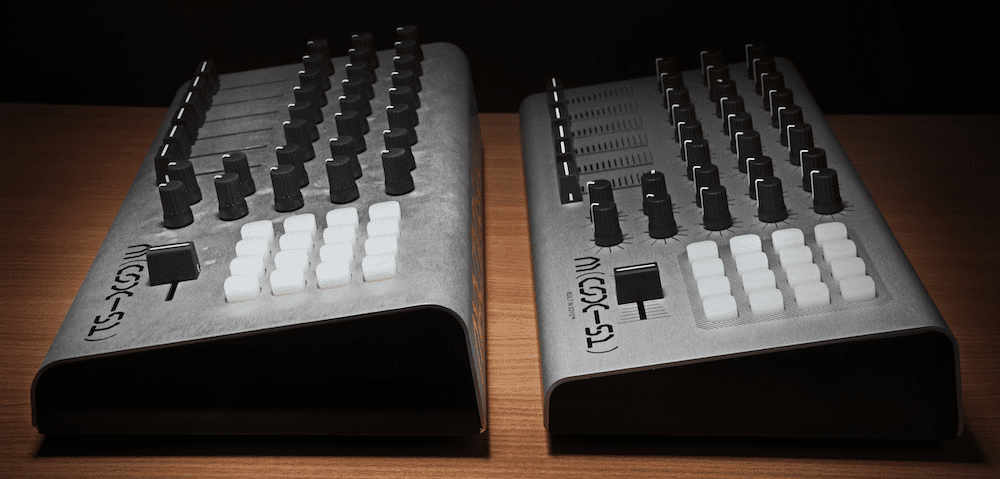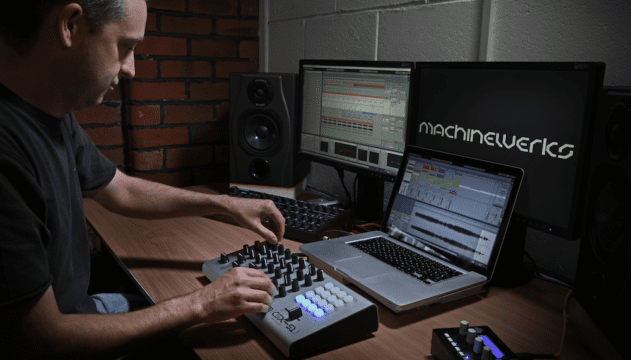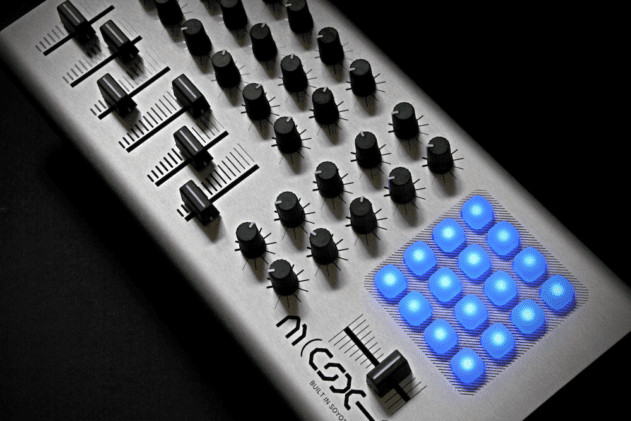As South Yorkshire techno stalwarts The Black Dog launch a new hardware company, we asked Martin Dust to tell us a little about the motivation behind the project, the design process for their first product and their reasons for choosing to manufacture in the UK.
Given the obvious benefits of involving artists in the design process, it’s surprising how few manufacturers of dance-focused hardware and software fully engage with the artist and DJ community. Guitar, bass and drum manufacturers bend over backwards to obtain artist endorsements for signature models, carefully crafted to suit the exact needs of each musician, but for some reason electronic music companies have always seemed a little more reticent to consult professional electronic musicians for product suggestions and major design decisions. Sure, you’ll see the occasional artist endorsement, but in the world of electronic music that’s typically just a marketing tool rather than a sign a particular artist’s been involved in developing the product in any way.
Instead, the onus often falls on artists to take matters into their own hands and develop the tools they need to create and perform their music. In many cases that means writing custom software, commissioning a bespoke synth or maybe hacking together a custom controller, but these instruments rarely reach a level of sophistication or universal appeal which justifies mass production.
What’s more interesting is what happens when an experienced artist spots a niche – a product which doesn’t exist and would also be useful to other producers – and dives head first into creating a commercial solution, drawing on their own experience to guide the research and development process. It happens relatively rarely, but when it does the results can be incredibly effective. Look, for example, at Ableton Live, first developed by Monolake’s Robert Henke and Gerhard Behles in response to their own assessment of the shortcomings of existing DAWs. Since its launch in 2001, Live has had a major impact on the way developers consider the needs of dance music producers when designing software.
The onus often falls on artists to take matters into their own hands and develop the tools they need to create and perform their music.
The Black Dog are usually introduced using the same old cliches: Sheffield techno legends… Warp Records… line-up changes… But one crucial factor which is often overlooked is their consistent passion for progression – a refusal to stand still and repeat the same thing. Over the last 12 years, Ken Downie, Martin Dust and Richard Dust have consistently explored new musical ideas. The trio’s latest project, however, is an altogether more radical departure than a change of sound.
Frustrated at weaknesses in existing electronic music gear and inspired by the idea of creating tools to help other musicians, the trio have formed a new hardware company, Machinewerks. As Martin Dust explains, Machinewerks is “a Black Dog project [but] Ken is living on a boat in the middle of nowhere at the minute so his input is limited and we’ve brought Das onboard to help with the electronics. I guess it’s more of a collective really where people move freely between music and making equipment.”
The first Machinewerks project is the CS X51 USB/MIDI control surface, which launched on Kickstarter last week and, at the time of writing, has raised just under £7k of its £27k funding goal, with 24 days remaining. Future plans include a DJ controller and a mixer. We asked Martin to explain some of the reasons for launching Machinewerks and to talk us through the development of the company’s first product.
Martin Dust writes…
The roots of Machinewerks: years of market research
For years we’ve been using other people’s controllers but have never really been happy with what’s available. They often didn’t have enough controls, were too big and heavy for regular travel, or they always had loads of features we’d never use. Some of the quoted features looked great but when it came down to it, we’d never use them when playing out. The ‘cool’ features just ended up being a useless novelty.
We wanted to design something pure that delivered the essential features in a high quality form, while avoiding those eye-catching gimmicks. It had to be something that we wanted to own, something we could gig with and use in the studio.
Everybody has their own idea about how to apply a MIDI controller to their setup, but these ideas change once you start trying to use it for real. A lot of seemingly good ideas are impractical once you’re mixing or jamming in the studio – they can actually break your workflow. We’ve spent the last eight months trying things out. It breaks your heart when you think you’ve found a great idea, only to find that it just doesn’t work once you’ve built it!
We wanted to design something pure that delivered the essential features in a high quality form.
It also got to the point where everything we owned was getting old and failing. It just wasn’t built for the heavy use we put things through. I dropped my Bitstream
and it hasn’t worked since. Ken and Rich’s controllers started changing volumes on their own as the pots began to fail! It was time to do something. Unfortunately, many of the controllers currently available seemed to be a compromise and for us that was the start of it all. We knew that we could build something better and figured that we can’t be the only people who wanted this. We’re now about to find out if that is actually true.



04.45 AM
Sorry, but i predict this is going to fail.Why ? Well, because first of all their controller reminds me a lot of everything Livid Instruments has already done.Plus Livid offers all kinds of DIY stuff already so the question is where is Machinewerks USP against Livid ?! I don’t see any.
Second, the controller is missing quite a number of essential controls in my book – like, if you wanna use it in Ableton Live, where are the 3 buttons per channel for mute/solo/arm ? Don’t tell me to shift click the pads on the right for that, we got enough controllers out there with shift click double and triple functions.Just an example for missing functions, i could go on.
Third, watched your vid on kickstarter and honestly guys, is this the way confident, excited, trustworthy entrepeneurs look nowadays ? I mean really, the first guy in the video shows a sad face expression that says “help us, pleaaase !” and the other guys don’t come across very confident either.I know, it’s just an image thing, but no, it’s not.
Last, do you really think it’s SUCH a good idea to post broken gear pics of your competition to make them look bad ? Sorry, might rather make YOU look bad.
Sorry, i don’t wish you any bad or anything, but it just looks like there were some steps and thoughts that you left out during the process so far.
06.48 AM
Frank, you sound like the worried MD of a rival product.
Did you not read the interview or watch the clip? As The Black Dog they’re playing a lot of gigs around the world and have found various failings with the controllers currently available ie they’ve found a gap in the market.
You mention buttons missing blah blah blah. They’re taking their R&D from Berghain at 6am, it’s fair to assume they know what they want.
As for “excited entrepeneurs”, you really are coming across like a proper clown with that paragraph. Maybe they’re just trying to get on and build the controller rather than poncing around “business hubs” and “networking get togethers”.
10.28 AM
“business hubs” and “networking get togethers” ….. massive waste of time in any industry… and total distraction to actually getting on with any start up – avoid at all costs .. and besides who wants to hang out with your competitors?
11.15 AM
Frank, would you really prefer it if the video showed “confident, excited entrepreneurs” instead of The Black Dog?
The whole point of the Kickstarter/indiegogo/crowdfunding model is to give the company direct access to the customer. It turns the whole process of seeking investment into a very simple equation: make cool shit, set a fair price and if enough people want it you’ll get your funding. That’s about as democratic as it gets, and a lot better than dressing up in your best suit to beg the bank manager to lend you some cash. They’ve already raised £8k and even though I don’t personally need a control surface I hope they hit their target.
This isn’t Dragons’ Den. This is all about the product. Maybe if TBD were complete unknowns people might be worried about how they present themselves, but their back catalogue tells the story there. This isn’t Duncan Bannatyne saying “Your expression was sad in the video and you weren’t wearing a tie so for that reason I’m out”. It’s the fucking Black Dog. They know what they’re talking about. If you like it, fund it. If you don’t, don’t.
04.39 PM
My question is: WHAT will differentiate these from, let’s say, Livid controllers, aside from having TBD attached to it. The video is weak at making the case of why we should buy these instead of the competition. If I have a bunch of controllers already, why will this one make a differenc eand eplace them all?
11.57 PM
What Alan said.My main gripe with the video is that for people like me that DO NOT know TBD but might be interested in a controller they just don’t come across as confident and trustworthy.If they rely solely on their reputation than thats a missed opportunity because there ARE people out there that might be interested in investing in a controller but just don’t know THEM so for these people the video DOES play a factor.
And video aside, as has already been said i just don’t see what their controller offers that hasnt already been done by Livid.Just to say “they play at Berghain and know what they do so buy or get lost” might not be the most clever marketing stragtegy, at least not to people that -again – dont know them but are interested in controllers.
Oh yeah btw, i’m not working for Livid nor do i own any instruments by them.I’m just interested in controllers and thus am aware of their product line.
11.59 PM
I appreciate the effort, but this is just another box with knobs and buttons. There’s no shortage of these out there already. Best of luck.
02.24 PM
my only comment is, the goal of 27k is a bit of a stretch, this project could have happened for less imo, and considering that most people will wait for v2 rather than v1 of the hardware (which is also reflected in 83 units out of 100 still being available) further proves this.
great idea, great product, but they havent studied the dynamics of kickstarter as well as they should have…. in all cases, good luck.
01.24 AM
Too much like a UC-33 for me to get excited, honestly. I’d love to be more excited about it.
As far as encoder controllers go I’ve used a UC-16, UC-33, BCR2000, Livid Code, and APC40. The APC, BCR, and Code all feature light-up infinite encoders that don’t require takeover in the DAW. I can see them on a dark stage when I’m using them live. The drawback of the BCR is the huge size and Fisher-Price build quality. The drawback of the Code is the notched encoders (imho, they should be smooth like an APC or Push). The drawback of the APC is that it only has 16 encoders.
What is the differentiator for this device? Is it better build quality alone? It lacks infinite controllers with feedback from the DAW that the APC, Code, and BCR all have. You can get a couple Akai LPD8’s for $50 each if you mind having knobs with limited rotation and a physical notch to indicate the current value (which you’ll have to check by touch on a dark stage)… they’re affordable and have Akai build quality.
I just don’t see it…
08.14 AM
Yes, this does look like a copy of the Evolution UC33. And in my mind – that’s fantastic. UC33 is hard to come by in the states and Livid (who are also making something nice and SORT OF similar) haven’t made the exact setup that many of us want for performance: 8 Faders. With THREE KNOBS directly above each fader, so you can known in an instant what knobs go with what faders. It’s a simple design that the APC40 got horribly wrong.
09.41 AM
Really hope that your project moves forward, honest and conscientious people trying to build a quality product in a market where gimmicks and cheap components are rife. However I have to say that I’m surprised that the final design is as it is, being an Ableton tutor, DJ and producer for many years now I have tried and tested pretty much every controller on the market. Some of the features are, as previously stated, the ‘go-to’ default for DJ-style multitrack mixing (3 knobs above faders) for example. I like the 4*4 grid but it doesn’t relate to the fader count and one of the defining criteria in my own choices is that each track must have at least one hard toggle switch with light indicator, for track on/off. My device of choice is the MPD32, has been on tour with me for years now, bomb proof and all the right controls (except the 3 knobs per track), trouble is it’s big. I also carry a number of other smaller controllers but over the past 6 months I’ve been cautiously moving over to iPad with TouchOSC or Lemur… what can I say, I can design my own multi-touch interface, fully labelled, with feedback and all the controls I need where I need them… I genuinely can control more stuff with less hands with the only outstanding issue being reliability of connectivity and of course the old problem with Betty Swallocks in the club making my iPad all wet and slippy. I’m taking time out to write this cos I really support your ethos and I want to see more homegrown product. I’m headding to Berlin for my Ableton Certified Trainer assessment in a couple of weeks and my final point was that in your video you do not show the potential control setups for Ableton or Traktor or any other product which I think is vital considering the audience/market are gonna want to see how YOU implement it, it’s as much about the workflow and template as the controller itself. I can also think of a product or two that might actually break some new ground and would be happy to discuss this and other help I could give you with promotion, videos, demonstrations etc. Once again, good luck, stick to your ethics, I’d love to be buying quality stuff ‘Made in England’.
11.40 AM
No MIDI controller will ever satisfy the general needs to a point where said product will be the only one/the go-to, as we all hanker for a controller that allows you to control everything you set your eyes on.
E.G. What works perfectly layout-wise for Massive will not work for Diva, etc.
The only solution will be a MIDI controller where the knobs, faders, etc. can be plugged in/removed in a modular manner to motherboards (for want of a generic term) of, say, three different sizes…a bit like Lego. I believe that there was one such project on the same lines some years ago, but it disappeared without trace.
03.23 PM
Just remembered…the one I was on about was the Mawzer Modular MIDI controller (shown at Muzikmesse 2007, disappeared without a trace). Livid have one as well, but the modules still lack something in relation to my needs.